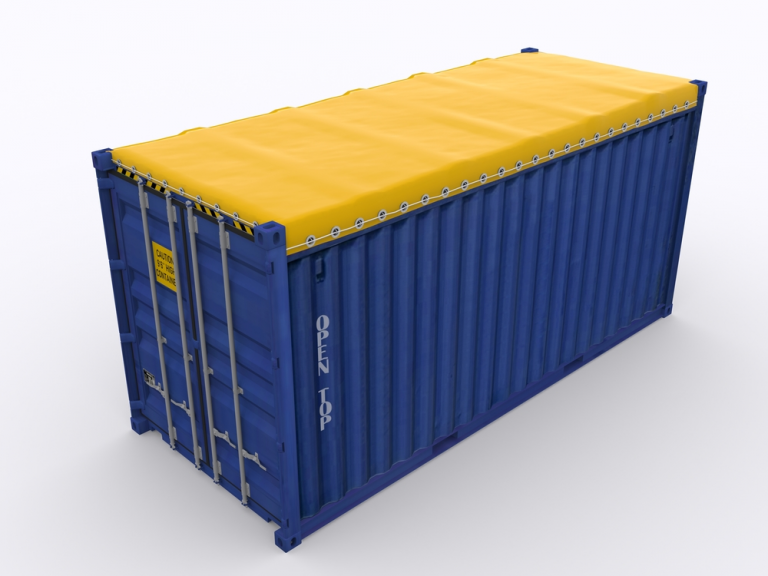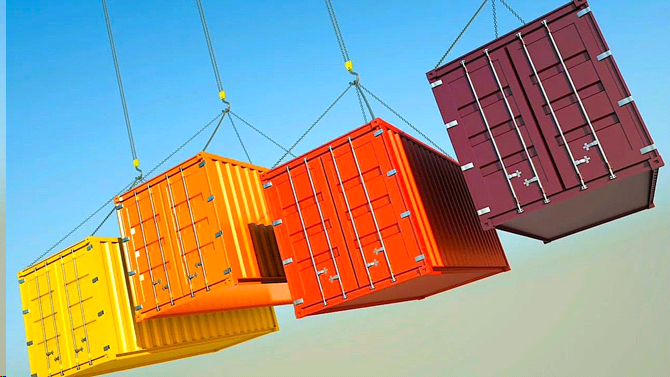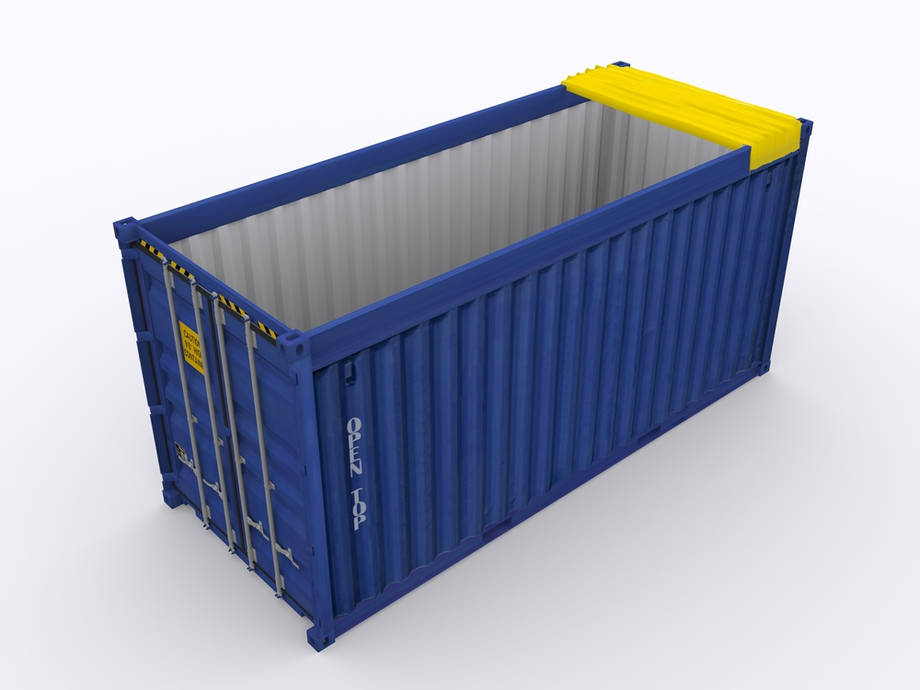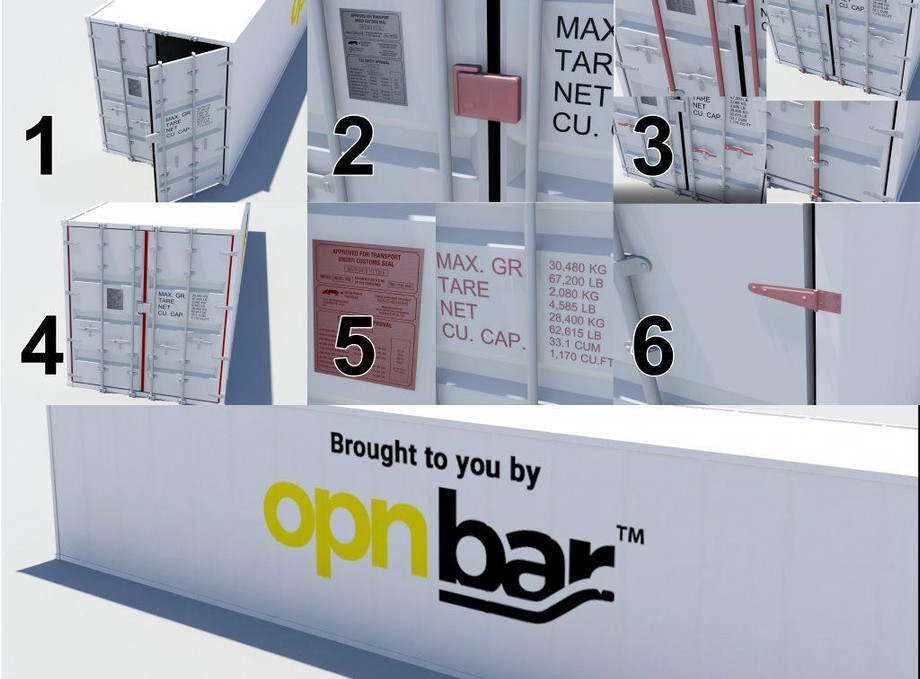
Shipping Containers are the cargo containers that allow goods to be stored for transport in trucks, trains and boats, making intermodal transport possible. They are typically used to transport heavy materials or palletized goods. Shipping container s are used to protect transported cargo from shock and bad weather conditions, as well as keep storage products intact. They were first used in the 1950s and were initially developed for the purpose of commercial shipping.

Shipping container s are also referred to as, ISO container, conex box, railroad container, intermodal container and certain truck trailers. This industry term refers to the International Standards Organization (ISO), the largest developer of international standards and the organization that developed the standard dimension specifications for steel shipping containers used worldwide.
The design of the ISO standard containers allows for intermodal shipping, which is the movement of containers from one mode of transport to another, like ship, rail, or truck, without the need of having to load and unload, and reload its contents.
Shipping Containers are used to protect transported cargo from shock and bad weather conditions, as well as keep storage products intact. They were first used in the 1950s and were initially developed for the purpose of commercial shipping container transport.
Depending on the type of product that is going to be sent, the Shipping Container can vary in dimension, structure, material, etc. Characteristics of these shipping containers were later standardized, something that expedited transport without the need to load and unload the merchandise along the way.
There are different types of Shipping Containers for different types of transportation:
Common Types of Shipping Containers
In the world of global trade and transportation, shipping containers play a pivotal role in ensuring goods reach their destinations safely and efficiently. These versatile metal boxes come in various shapes and sizes, each designed to cater to different types of cargo, modes of transportation, and storage requirements. In this article, we delve into the fascinating world of shipping containers, exploring the different types and their unique characteristics.
Dry Containers
Dry containers, also known as standard containers, are the most common type used for transporting a wide range of dry goods. These containers are typically made from steel and are available in two standard sizes: 20 feet and 40 feet. They are designed to keep cargo dry and protected from external elements during transit, making them suitable for products such as electronics, textiles, and packaged goods.
Refrigerated Containers (Reefers)
Refrigerated containers, or reefers, are specially designed to transport perishable goods that require temperature control, such as fruits, vegetables, pharmaceuticals, and certain chemicals. These containers are equipped with built-in refrigeration units that maintain specific temperature ranges throughout the journey. Reefers are available in various sizes and are essential for preserving the quality of temperature-sensitive cargo.
Open-Top Containers
Open-top containers are designed to accommodate oversized cargo that cannot be loaded through the standard container doors. These containers have a removable top, which allows for easy loading and unloading of goods from the top using cranes. They are ideal for transporting heavy machinery, construction equipment, and goods with non-standard dimensions.
Flat Rack Containers
Flat rack containers are suitable for carrying irregularly shaped or bulky cargo. They have collapsible sides that allow for easy loading from the sides or the top. This type of container is commonly used for shipping vehicles, boats, and large machinery.
Tank Containers
Tank containers are designed for transporting liquids and gases, including chemicals, food-grade liquids, and hazardous materials. These containers have cylindrical tanks made of stainless steel and are equipped with safety features to prevent leaks or spills. They come in various sizes and can be loaded onto various modes of transportation, including ships, trains, and trucks.
Open-Sided Containers
Open-sided containers, as the name suggests, feature doors that open along one entire side. This design facilitates easy loading and unloading of cargo that may be heavy or awkwardly shaped. Open-sided containers are commonly used for transporting goods such as timber, pipes, and construction materials.
Double-Door Containers
Double-door containers have doors at both ends, enabling access to the container from either side. These containers are particularly useful for efficiently loading and unloading cargo, as well as when items need to be accessed from both ends during transportation.
Insulated Containers
Insulated containers are designed to protect goods from extreme temperature fluctuations. They are equipped with insulating materials that help maintain a consistent internal temperature, making them suitable for goods that require a controlled climate but not necessarily refrigeration. These containers are often used for transporting pharmaceuticals, chemicals, and certain food products.
Shipping containers are the unsung heroes of international trade, providing a safe and efficient means of transporting goods across the globe. From dry containers that secure everyday commodities to specialized reefers that ensure perishables arrive fresh, the variety of container types cater to the diverse needs of industries and businesses worldwide. As the global economy continues to grow, the role of shipping containers remains paramount in sustaining the flow of goods and maintaining the interconnectedness of our modern world.

Shipping Container Door Diagram and Troubleshooting
Now we are going to run through the essential parts of a shipping container.
- For a door to work, you need hinges. Pins hold the shipping container's hinges together through a barrel. In certain cases when doors are difficult to open, hinge pins and blades may be seized due to corrosion. Each door is fitted with 2 to 4 vertical lock rods to enable opening, closing and locking of the doors.
- The door handle rotates the lockbar to initiate the door opening process by forcing the cams out of their keepers. Each door handle has a door locking handle retainer that slides over the door handle when in locked position.
- At the end of each lock rod is a cam welded in place which engages with knuckles, also known as cam keepers. The action of engaging the cams to the keepers forms an anti-racking function. In certain cases, often unfortunately too many, contents of the shipping container may have shifted causing shipping container doors and lockrods to warp.
- When opening a shipping container, start with the right hand door first. Swivel the handles, engage the cams and keepers, and twist both door handles. Closing the doors is just a reverse of this process.
- The lock box is a steel box welded to the right hand door which overlaps a staple welded to the left hand door. A padlock, normally CISA type 285 66 can then be attached inside the lock box through the staple and is then protected from direct attack, hindering attempts to gain entry to the container.
- ISO markings and a consolidated data plate allow worldwide intermodal transport and are updated as necessary. Take note that customs authorities in some countries may also have their own container seal regulations as part of their national security.
- Rubber gaskets are fitted to the container doors during the manufacturing process and prevent water ingress. Door gaskets are designed to present two or more fins against the structure or adjacent door. These are generally flexible but when the gasket is damaged, they may become stiff thus jamming the door closed, or preventing it from being closed.
- Doors
Two door leaves are fabricated from two vertical rolled hollow sections and 2 horizontal c section members. The frame is infilled with corrugated steel paneling.
These are normally attached to the rear corner posts each with four drop forged steel hinge blades. The blades allow 270 degree opening which allow the doors to swing back against the container side wall.
(Cargo may shift during transit. Look at the container to make sure that the doors are aligned and level, both top and bottom. In cases where the container frame is racked and the door gear will not operate correctly.)
- Lockbox
The lock box is a steel box welded to the right hand door which overlaps a staple welded to the left hand door. A padlock, normally type CISA type 285 66 can then be attached inside the lock box through the staple and is then protected from direct attack, hindering attempts to gain entry to the container.
- Lockrods, cam keepers, handles
Each door is fitted with 2-4 vertical lock rods to enable opening, closing and locking of the doors.
At the end of each lock rod (top and bottom) is a cam welded in place which engages with knuckles, also known as cam keepers.
The action of engaging the cams to the keepers forms an anti-racking function.
(In certain cases, often unfortunately too many, contents of the shipping container may have shifted, or containers even dropped, causing shipping container doors and lockrods to warp)
The door handle rotates the lockbar to initiates the door opening process by forcing the cams out of their keepers. Each door handle has a door locking handle retainer that slides over the door handle when in locked position.
- Rubber gaskets
Rubber gaskets are fitted to the container doors during the manufacturing process and prevent water ingress.
(Door gaskets are designed to present two or more fins against the structure or adjacent door. These are generally flexible but when the gasket is damaged, they may become hard or blocked thus jamming the door closed, or preventing it being closed.)
- ISO markings and CSC plate
ISO markings and a consolidated data plate allow worldwide intermodal transport when left in place and updated as necessary.
- Hinge pins
Of course for a door to work, you need hinges.
(In certain cases when doors are difficult to open, hinge pins and blade are seized due to corrosion.)

Choosing the Right Company for Buying a Shipping Container
When doing research in finding the right Shipping Container, follow some of these tips:
Research Online
Choose which companies have a good track record of excellence and reputation. Read reviews and what other customers have to say.
Check for Availability
If you are shipping from various locations, check for availability if containers can be delivered to your required areas.
Check for Best Pricing
If money matters, you can find used container resellers online that might be able to offer half the price on used containers.
Check for Good Customer Service
If you plan to order often, you might want to check for good customer service. Ask potential container companies a question through email or their online customer service. See how fast they respond.
Check for Warranty
Check with companies to see if they offer any warranties or buy back or trade in plans.
There are millions of Shipping Containers in use around the world, and a lucky few get a second life as repurposed shipping container structures. While they look a bit plain and boxy to the untrained eye, shipping containers play a critical role in our lives, whether embarking on ocean crossings to deliver the goods we use every day or venturing into a second life as a container structure.
Here are Some Fascinating Facts about Shipping Containers
- Shipping Containers can be safely stacked nine-high.
- Well-maintained Shipping Containers hold 759, of their original value for 25+ years.
- There are over 37 million Shipping Containers in use around the world.
- A Shipping Container floor can hold up 55,000 lb. of goods without warping.
- Shipping Container flooring is made of 1-1/8” marine grade plywood.
- Most Shipping Containers are 20 feet or 40-feet long.
- Shipping Containers are made of 16-gauge corten steel.
- Common container modifications include: personnel doors, windows flooring, shelving, work stations, insulation, climate control & even restrooms.
Fun Ways to Use Shipping Containers
Shipping Containers are not just used for cargo these days. There are many innovative and imaginative uses you may like to consider.
Here are few ideas of how shipping containers have been used for modern, cost effective buildings.
Homes
The trend to build cost-effective homes from recycled shipping containers started in USA and has reached Australia.
Art Galleries
Architect, Tomokaza Hayakawa designed an art gallery in Japan using two shipping containers stacked on each other.
Drive-Thru Coffee
Starbucks in Washington have used four old shipping containers to create an architect designed drive-thru store.
Cafes
A cafe in Footscray (Melbourne) called Rudimentary has been built using three 40-foot shipping containers.
Polar Stations
India has built a Polar Station in Antarctica using 134 shipping containers. They cover three floors and are well insulated for the weather conditions.
A well-maintained Shipping Container can hold 75% of their original value for 25+ years. Every day, container ships transport goods all over the world on the international seas.

Shipping Container Opening and Closing Tool
Shipping containers often take a beating, traveling around the world, being exposed to freezing conditions and rust due to seawater or when the frost has melted.
During the cold season, and in freezing parts of the world, our shipping container tool can benefit the opening and closing of frozen shipping container doors and hard to open or rusted containers.
Injuries often occur as a result of personnel trying to open and close difficult container doors, and often are the result of inappropriate techniques being used to open them.
To aid in opening and closing shipping container doors, we introduce OPNBar.
A Shipping Container (also known as Intermodal Container, ISO Container,Railroad Container, and certain Truck Trailers) is a large standardized shipping container, designed and built for intermodal freight transport. Shipping Containers can be used across different modes of transport. They can go from ship to rail to truck, without unloading and reloading their cargo.
The metal doors on the shipping containers on these containers are standardized. Shipping Containers use the same type and style of doors and locking bars, which our tool can be used.
Lengths are as follows: 20′, 40′, 45′, 48′, 50′, 53′. All these containers are globally used to transport cargo. The 53′ length is now, the new the standard length.
Here are some likely reasons a Shipping Container door will not open or close. Visit https://www.shippingcontainertool.com/what-is-a-shipping-container/ to find out how to overcome some of these issues.
Doors and lockrods may warp or container frame is racked so that the door gear will not operate correctly. This may be caused by cargo shifting during transit. Look at the container to make sure that the doors are aligned and level, both top and bottom.
The hinge pins and blade are seized due to corrosion.
The door gasket has been damaged and is preventing opening. Door gaskets are designed to present two or more fins against the structure or adjacent door. These are generally flexible but when the gasket is damaged, they may become hard or blocked thus jamming the door closed, or preventing it being closed.
Water has become trapped between frozen shipping container doors, particularly relevant to refrigerated cargoes, or containers with moisture releasing cargoes in cold weather.
Please visit:- https://www.youtube.com/watch?v=N3pUEuZRg9c&feature=emb_title
Mailing Address:
10053 Whittwood Dr, Suite
11284 Whittier,
CA 90603 USA
657.6.OPNBAR (657-667-6227)
Website:- https://www.shippingcontainertool.com/what-is-a-shipping-container/
























